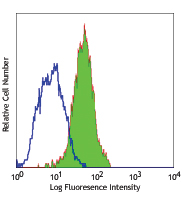- Clone
- QA20A36 (See other available formats)
- Regulatory Status
- RUO
- Other Names
- Platelet-derived growth factor receptor, beta polypeptide, PDGFR1, PDGFRβ, PDGFRb, PDGF receptor beta
- Isotype
- Mouse IgG1, κ
- Ave. Rating
- Submit a Review
- Product Citations
- publications

-

Human PDGFRB transfected cells stained with purified anti-human CD140b (clone QA20A36) (filled histogram) or purified mouse IgG1, κ isotype control (open histogram) followed by PE anti-mouse IgG.
| Cat # | Size | Price | Quantity Check Availability | Save | ||
|---|---|---|---|---|---|---|
| 383002 | 100 µg | $118 | ||||
CD140b is a cell surface tyrosine kinase receptor for members of the platelet-derived growth factor family. The identity of the growth factor bound to the receptor determines whether the functional receptor is a homodimer or heterodimer composed of both PDGFR-α and -β. CD140b contains two immunoglobulin-like domains and a tyrosine kinase domain with a predicted molecular weight approximately 124 kD. CD140b is widely expressed on a variety of mesenchymal-derived cells and is preferentially expressed on some tumors such as medulloblastoma. Binding of B-chain containing PDGF molecules can stimulate cell proliferation. CD140b has been shown to interact with a number of kinases (including Raf-1, NCK1, FAK, Fyn, others) as well as adaptor molecules and signaling intermediates (Crk, Grb2, Grb4, RasGAP, SHP2, SHC1, others), and has also been shown to associate with integrin β3 and nexin sorting molecules. CD140b has been implicated in several disease states including atherogenesis and oncogenesis. The PDGFRβ is heavily phosphorylated on numerous tyrosine residues through both autophosphorylation and ligand-dependent processes.
Product DetailsProduct Details
- Verified Reactivity
- Human
- Antibody Type
- Recombinant
- Host Species
- Mouse
- Formulation
- Phosphate-buffered solution, pH 7.2, containing 0.09% sodium azide
- Preparation
- The antibody was purified by affinity chromatography.
- Concentration
- 0.5 mg/mL
- Storage & Handling
- The antibody solution should be stored undiluted between 2°C and 8°C.
- Application
-
FC - Quality tested
- Recommended Usage
-
Each lot of this antibody is quality control tested by immunofluorescent staining with flow cytometric analysis. For flow cytometric staining, the suggested use of this reagent is ≤ 0.25 µg per million cells in 100 µL volume. It is recommended that the reagent be titrated for optimal performance for each application.
- RRID
-
AB_2927818 (BioLegend Cat. No. 383002)
Antigen Details
- Structure
- Cell surface tyrosine kinase receptor for members of the platelet-derived growth factor family. The identity of the growth factor bound to the receptor determines whether the functional receptor is a homodimer or heterodimer composed of both PDGFR1 and PD.
- Distribution
-
Widely expressed on a variety of mesenchymal-derived cells. Preferentially expressed in medulloblastoma.
- Function
- Stimulation of cell proliferation; mitogenic activity for cells of mesenchymal origin. Has been implicated in atherogenesis and oncogenesis.
- Interaction
- Interacts with a number of kinases (including Raf-1, NCK1, FAK, Fyn, others) as well as adaptor molecules and signaling intermediates (Grb2, Grb4, RasGAP, SHP2, SHC1, Crk, others). Has also been shown to associate with integrin β3 and nexin sorting molecules.
- Ligand/Receptor
- Binds to B-chain containing PDGF molecules as well as protease-activated PDGF-C
- Antigen References
-
- Claesson-Welsh L, et al. 1988. Mol Cell Biol. 8:3476-86.
- Gronwald RG, et al. 1988. Proc Natl Acad Sci U S A. 85:3435-9.
- Gilbertson DG, et al. 2001. J Biol Chem. 276:27406-14.
- Seifert RA, et al. 1989. J Biol Chem. 264:8771-8.
- Kanakaraj P, et al. 1991. Biochemistry. 30:1761-7.
- Gene ID
- 5159 View all products for this Gene ID
- UniProt
- View information about CD140b on UniProt.org
Related Pages & Pathways
Pages
Related FAQs
Other Formats
View All CD140b Reagents Request Custom Conjugation| Description | Clone | Applications |
|---|---|---|
| Purified anti-human CD140b (PDGFRβ) Recombinant Antibody | QA20A36 | FC |
Customers Also Purchased
Compare Data Across All Formats
This data display is provided for general comparisons between formats.
Your actual data may vary due to variations in samples, target cells, instruments and their settings, staining conditions, and other factors.
If you need assistance with selecting the best format contact our expert technical support team.
-
Purified anti-human CD140b (PDGFRβ) Recombinant Antibody

Human PDGFRB transfected cells stained with purified anti-hu...
 Login/Register
Login/Register 












Follow Us